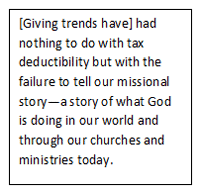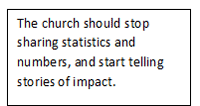New tax law and your organization

Will the changes in tax law really affect people’s giving to your church? Our friend and stewardship consultant, Mike Ward, thinks it won’t, and I agree. Here’s why…
OPPORTUNITIES TO RESPOND TO THE NEW TAX LAW TO BENEFIT YOUR ORGANIZATION
by the Rev. Mike Ward, CFRE

DEDUCTIBILITY OF GIFTS
One reason churches and other charities see such large revenues in December is that people are wanting to give before the end of the year so that they can claim this charitable deduction. The tax code has for decades held provision to allow for charitable deductions by those who “itemize deductions.” While the charitable deduction will still be allowed, the new standard deduction has basically doubled which will result in fewer people claiming this deduction. This means that people are getting as much or more deduction without having to itemize.
Approximately 70% of Americans in 2016 took the standard deduction and did not itemize. People with larger incomes tend to be more likely to itemize. Reasonably, the effect of losing the charitable deduction could be felt more by those with larger incomes who are currently your donors.** At the same time, most Americans with larger incomes will be receiving significant tax breaks. And a few of these large donors will still choose to itemize deductions.
I encourage you to not focus on deductibility of gifts. In my eighteen years of development experience with the church and church related organizations, I have found very few donors who are “deduction motivated.” Many appreciate that they can claim the deduction for tax purposes, but that isn’t why they give. Churches and other non-profit organizations should focus on what motivates donors to give and how to do a better job of raising up that motivation.
THE GIVING LANDSCAPE

Yes, mid-level and larger donors may lose out on their ability to deduct their gift to your organization. Many of these givers will actually realize a greater deduction with the new standard deduction, and most will have more money because their taxes will go down.
YOUR STORY TO TELL
Historically, churches and charities have benefited when people have had more money at their disposal, but the benefit is not as much as might be expected. Instead, both churches and charities improve giving to the greatest extent when telling their stories well—stories of lives changed, impacts made as a result of the generosity of donors.
What I have seen from many churches is simply telling a financial snapshot. They share how much expenses exceed revenue and tell people the need is for more money. This is simply sharing information, and it makes it about money and not mission. A college once shared with me the cost of the electric bill. This is not motivating to most donors, especially me. Sometimes, we share good information, such as we had 100 children participate in Vacation Bible School and this is good, but it can be better. The church should stop sharing statistics and numbers, and start telling stories of impact. Tell the story of the youth who helped lead Vacation Bible School and came to understand their God given gifts. Tell stories of how pastoral care helped someone see God active in their life. Tell the story of how Sabbath rest in worship renews people who feel beaten up by the world.

IMPLEMENTATION STEPS
To best position your organization and your most faithful and generous supporters to navigate this new tax code, consider implementing these steps as the new year begins:
- In January and February have intentional conversations with 12-20 mid to upper range donors ($3,600 and up in most churches/$1,000 and up in most organizations). Ask them what the new tax law means to them. Together, determine strategies to help them. For instance, some donors may start giving every other year to lump their giving to take a deduction every other year. Being aware of their giving intentions will enable better financial planning for your organization’s leadership.
- After the first quarter, evaluate each donor (or donors of a certain level or above), and check on how their giving compares to previous years (or their pledge). Contact any who are behind to encourage their continued support.
- Evaluate the stories of impact that you share and determine that they are reaching your target audience.
- Invite a few donors to share their intention to maintain or even increase their giving in the coming year because they love the ministry of the organization and feel it makes a difference. They can even state that the tax law is not a factor in their giving decision.
- Provide prospective supporters a vision for more ministry that your organization can provide. People give to vision. Shrinking organizations normally get less money as donors become underwhelmed by the limited impact.
- Encourage donors to give appreciated stock. They still avoid capital gains taxes.
EXPECTING MORE MINISTRY TO HAPPEN
Ministry needs will continue to grow in the future. Most of the churches (over 60) and organizations (over 10) that I worked with in 2017 are expecting more ministry to happen in2018 than in 2017, and I believe that they will experience that. Several churches are expecting20% or more growth for ministry in the next year, and givers have indicated their commitment to support this growth. While the new tax code has left non-profit organizations concerned about its impact on givers, I remind you that the tax bill was working through Congress as organizations made these plans and as donors made their commitments to support them. The needs addressed by these ministries and the donor desire to partner with them supersedes tax reform.
The world is changing around us, but as we vision a world that God is active in, we can dream boldly and live into those dreams.
* Mike Ward is Partner at Gronlund, Sayther, Brunkow in addition to holding an M. Div. Contact him at wardgsbfr.com.
** See “Who Itemizes Deductions” posted by the Tax Foundation (2/22/16)
He suggests “New Tax Plan: Here’s What You Should Know” by Hayden Adams (12/20/17) from Charles Schwab & Co., Inc. for information about the tax law itself.
Ward calls “Charities fear tax bill could turn philanthropy into a pursuit only for the rich” by Todd C. Frankel (12/23/17) from the Washington Post an interesting article about the impact to giving.



